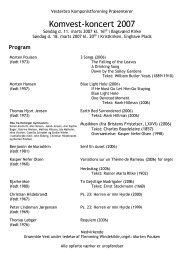Asger Hamerik's Choral Symphony - Life, Death and Immortality
Asger Hamerik's Choral Symphony - Life, Death and Immortality
Asger Hamerik's Choral Symphony - Life, Death and Immortality
You also want an ePaper? Increase the reach of your titles
YUMPU automatically turns print PDFs into web optimized ePapers that Google loves.
Kor-Symfonien har været en slags åndeligt testamente for <strong>Asger</strong> Hamerik, og teksten og dens musikalske<br />
realisering afspejler hans livssyn såvel som hans kompositoriske credo, nemlig en udogmatisk religiøsitet i slægt<br />
med samtidige unitariske tendenser og en nærmest positivistisk holdning til komposition som en kunst, der klart og<br />
entydigt skal formidle musikkens budskab.<br />
Men budskabet i Kor-Symfonien er netop både kosmopolitisk og eklektisk, præget som det er af samtidens<br />
religiøse tendenser, som søgte at bygge bro mellem tro og viden, og tonesproget er også eklektisk med<br />
reminiscenser af Liszt og Wagner, tilføjet elementer af en art nordisk ‘kunstnerisk folketone’.<br />
Med udgangspunkt i Kor-Symfonien vil jeg opfatte det som indlysende netop at fremhæve <strong>Asger</strong> Hamerik som<br />
eklektikeren og kosmopolitten bl<strong>and</strong>t det sene 1800-tals danske komponister og netop på dette grundlag se, med<br />
hvilken kunstnerisk konsekvens og sikkerhed han gav sine værker et unikt og personligt indhold.<br />
<strong>Asger</strong> Hameriks <strong>Choral</strong> <strong>Symphony</strong> - <strong>Life</strong>, <strong>Death</strong> <strong>and</strong> <strong>Immortality</strong><br />
***<br />
The Danish composer <strong>Asger</strong> <strong>Hamerik's</strong> so-called <strong>Choral</strong> <strong>Symphony</strong> (op. 40, 1898-1906) is written for chorus,<br />
orchestra <strong>and</strong> mezzo soprano solo to a text by Hamerik himself. This opus is written in 1898 but revised 1901-1906<br />
<strong>and</strong> published in 1908.<br />
Hamerik figures in Danish music history as - according to the opinion of several sources - an important but<br />
neglected symphonist, in who's opus this <strong>Choral</strong> <strong>Symphony</strong> plays a leading role in the fullfilment of his artistic<br />
ambitions.<br />
In his own time he often seems to have been blamed for being to eclectic, shallow <strong>and</strong> banal. In contradiction to<br />
this, modern Danish music history has tried to position him as an important transitional figure between Niels<br />
W. Gade <strong>and</strong> Carl Nielsen, especially due to his important symphonic production. Meanwhile, I find that this<br />
positioning conceals the unique artistic values present in a great deal of his work, especially in the <strong>Choral</strong><br />
<strong>Symphony</strong>.<br />
The issue in focus of this thesis is that the textual <strong>and</strong> musical structuring are formally linked to each other through<br />
the use of leitmotifs in the Wagnerian <strong>and</strong> Berliozian sense, <strong>and</strong> by creating a symbolic analogy between the<br />
content of the text <strong>and</strong> <strong>Hamerik's</strong> specific use of the principles of the sonata form in this opus.<br />
Therefore, the central part of the thesis - the internal musical analysis - points in the direction that Hamerik with<br />
this opus takes a completely different position than his eleged Danish role model Gade, <strong>and</strong> that he to a much<br />
higher extent has been inspired by the new German school <strong>and</strong> it's ideas of the Gesamtkunstwerk, where the<br />
4




